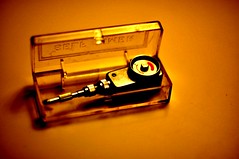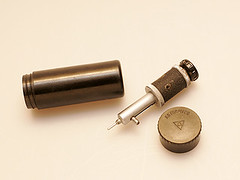Difference between revisions of "Self-timer"
m (V setting in old shutters, Vorlaufwerk or Vorlaufzeit or both?) |
m (changes attirbution from image_by to scan_by on the timer instructions) |
||
| (2 intermediate revisions by the same user not shown) | |||
| Line 7: | Line 7: | ||
Leaf shutters such as (Deckel Compur V - 1928) began offering a self timer which were marked with a '''V''' setting, this came from German, Vorlaufwerk (delayed operation) or Vorlaufzeit (delay time). | Leaf shutters such as (Deckel Compur V - 1928) began offering a self timer which were marked with a '''V''' setting, this came from German, Vorlaufwerk (delayed operation) or Vorlaufzeit (delay time). | ||
| − | Modern electronic cameras use digital timers | + | Modern electronic cameras use digital timers, with the ability to chose among several time settings. While this is common in the 2020s, it was quite revolutionary when the [[Canon A-1]] from 1978 could be set to delay exposure by 2 seconds (to dampen vibrations) or full 10 seconds, for the photographer to be in the picture. Some digital cameras allow for more than 1 set of time delays, and almost all electronic cameras signal the seconds counts down, either by beeps or flashing [[LED]]s as warnings, and then trip the shutter. |
{|class=plainlinks | {|class=plainlinks | ||
| Line 18: | Line 18: | ||
||electronic self-timer<br/>by {{image author|David Johnson}} {{with permission}} | ||electronic self-timer<br/>by {{image author|David Johnson}} {{with permission}} | ||
|}{{br}} | |}{{br}} | ||
| + | {|class=wikitable | ||
| + | | | ||
{{Flickr_image | {{Flickr_image | ||
|image_source= https://www.flickr.com/photos/89853469@N00/50979655031/in/pool-camerawiki/ | |image_source= https://www.flickr.com/photos/89853469@N00/50979655031/in/pool-camerawiki/ | ||
| Line 23: | Line 25: | ||
|image_align= left | |image_align= left | ||
|image_text= Instructions for use <br> Yashica Mechanical Self Timer | |image_text= Instructions for use <br> Yashica Mechanical Self Timer | ||
| + | |scan_by= Pablo Coronel | ||
| + | |image_rights= nc | ||
| + | }} | ||
| + | | | ||
| + | {{Flickr_image | ||
| + | |image_source= https://www.flickr.com/photos/titrisol/52277601582/in/pool-camerawiki/ | ||
| + | |image= https://live.staticflickr.com/65535/52277601582_2c0da4755f_m.jpg | ||
| + | |image_align= left | ||
| + | |image_text= Self timer in a leaf shutter <br> V setting gives a 10 second delay | ||
|image_by= Pablo Coronel | |image_by= Pablo Coronel | ||
| − | |image_rights= | + | |image_rights= cc |
}} | }} | ||
| + | |} | ||
| + | |||
| + | |||
[[Category: Camera parts]] | [[Category: Camera parts]] | ||
Latest revision as of 14:09, 9 December 2022
A self-timer is a mechanism which is used to trigger the shutter after a set period of time - allowing the photographer to be in the picture, or to avoid vibrations introduced by fingers. This mechanism is either built into the shutter release of a camera or used as an add-on accessory. Instructions for some older cameras may refer to this as a delayed-action mechanism.
Older mechanical self-timers, such as those on old Leicas or sold as accessory, typically employed some sort of a resistance coil. The user would pre-wind the coil to load it with tension, and then it would unwind. When it finished unwinding it would trip the shutter release. Accessory self-timers can be used by screwing into the shutter release button; and most have the ability to adjust the trip mechanism length to match the specific camera. A special type are self timers that can be used for the cable release instead of the shutter release button.
Leaf shutters such as (Deckel Compur V - 1928) began offering a self timer which were marked with a V setting, this came from German, Vorlaufwerk (delayed operation) or Vorlaufzeit (delay time).
Modern electronic cameras use digital timers, with the ability to chose among several time settings. While this is common in the 2020s, it was quite revolutionary when the Canon A-1 from 1978 could be set to delay exposure by 2 seconds (to dampen vibrations) or full 10 seconds, for the photographer to be in the picture. Some digital cameras allow for more than 1 set of time delays, and almost all electronic cameras signal the seconds counts down, either by beeps or flashing LEDs as warnings, and then trip the shutter.

|

|

|
| accessory self-timer by scenery_and_fish (Image rights) |
pneumatic accessory self-timer by Siim Vahur (Image rights) |
electronic self-timer by David Johnson (Image rights) |
|
|

